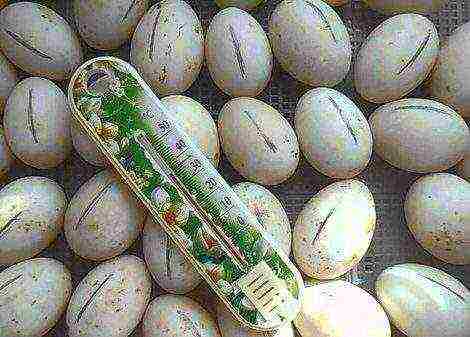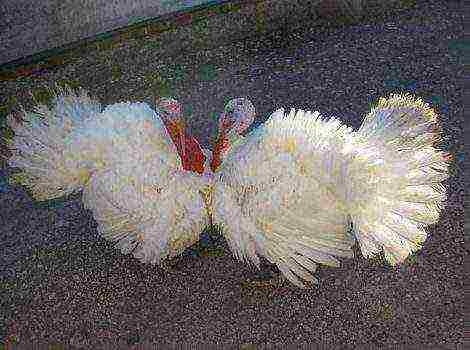Content [show]
Breeding turkeys at home
America is considered the birthplace of turkeys. Turkeys were domesticated about a thousand years ago. They came to Europe only in the 16th century, after four travels of Christopher Columbus.
Description
Turkeys are colorful, majestic and at the same time, poultry of different sizes. They love space and freedom.... From the first days of life in the turkey community, a hierarchy begins to build.
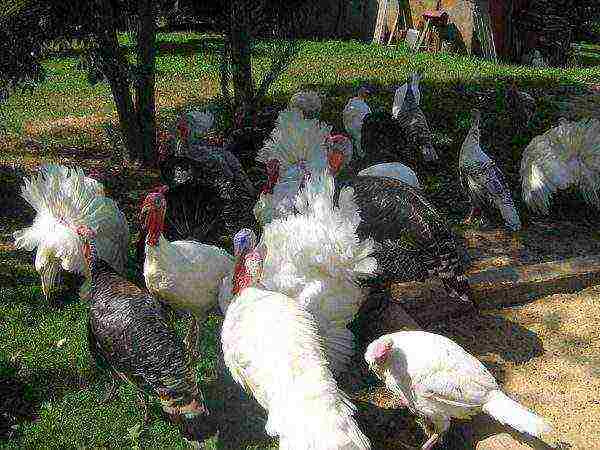
A brave and cocky male appears and gluttons are already visible - applicants for fattening for meat. In flocks of male turkeys, the right to fertilize female turkeys belongs to only one turkey, which is at the top of the hierarchy.
Pros and cons of withdrawal
The clear advantage of raising a turkey herd at home is getting wholesome meat and eggs. Turkey meat is a dietary meat that is low in cholesterol and high in minerals and vitamins.
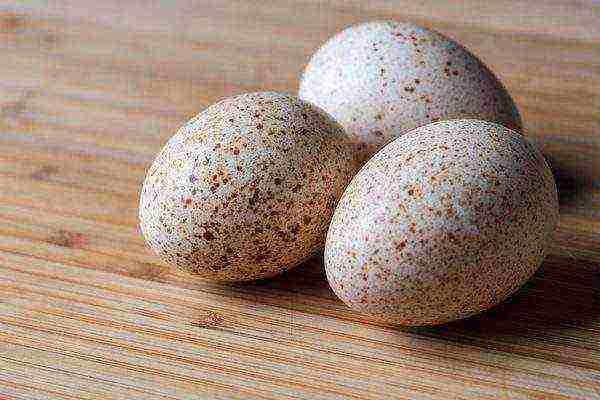
It is hypoallergenic and easy to digest, useful for pregnant women, young children and athletes. Eggs also have a large set of useful components, occupy the 3rd place in terms of the amount of nutrients, after quail eggs and guinea fowl eggs.
But, if we consider that turkey meat costs twice as much as chicken and eggs in terms of the amount of nutrients and weight three times higher than chicken, then this minus does not seem so significant.
The most famous breeds for breeding
The most common breed of turkeys for breeding in a private courtyard is the breed North Caucasian bronze... She has an elongated body, small chest and bronze plumage.
These birds are very mobile, long-legged and well adapted to foraging. Live weight of adult males from 13 to 18 kg, females 7-8 kg. Egg production of turkeys varies from 80 to 100 eggs per year.
A very profitable breed for keeping is white broad-breasted... They are classified into three main types:
- Heavy: the weight of males reaches 25 kg, the weight of females is up to 10 kg;
- Average: males weigh 15 kg and females 7 kg;
- Lungs: turkeys weigh 7 kg and turkeys up to 5 kg.

Turkeys mature for egg production by 9 months of age, bringing up to 115-125 eggs per year.
The broad-breasted bronze turkey breed has a high viability of young animals and almost one hundred percent fertility. The live weight of males is up to 18 kg, of females up to 10 kg.
Moscow white and bronze rocks are characterized by strong body construction, productive fertility and early egg production. Turkeys begin to lay as early as 6 months, they bring from 100 eggs per year. The live weight of males reaches 13 kg, females - 7 kg.
Conditions for keeping and growing
The main requirement in the maintenance of turkeys, which is worth focusing on, is the heat factor. Turkeys themselves are frost-resistant birds, but for full growth and development they need warmth and dryness in the enclosure.
The room should be frequently ventilated. It is not uncommon for turkeys to be kept in "former" chicken coops, which are slightly modified for larger birds.
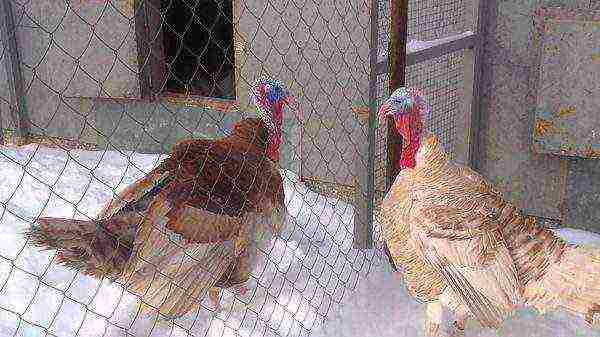
The main indicators of the pen for 10 turkeys:
- Square not less than 5 square meters, since up to 2 birds can be placed on 1 square meter (ideally, there should be 1 square meter per individual);
- Ventilation, to eliminate dampness;
- Straw bedding, which must be changed at least twice a week;
- Perches, arranged at a height of 70-80 cm from the floor, 5-7 cm wide and 8-10 cm high.
- Lighting can be carried out using a conventional electric lamp, the power of which should be 60 watts.
- In order not to start parasitic organisms in the turkey house, small boxes with sand and ash.
One turkey requires a minimum of 40 cm per roost, so there should be as many perches as the number of birds will be placed in the pen. The distance between the perches should be more than 60 cm.
Turkeys need constant walking. In the summer season, outdoor enclosures are set up for them near the poultry house, an area equal to the number of birds, at least one square meter is allocated per bird.
Conditions for arranging a summer enclosure:
- On the territory of the corral there should be a canopy, under which birds can hide from direct sunlight in hot weather;
- It will be ideal if it grows on the territory alfalfa, oats and cloverthat sow in early spring;
- Drinking bowls, the water in which should change as it gets dirty, at least once a day;
- Feeders with barley, or oats.
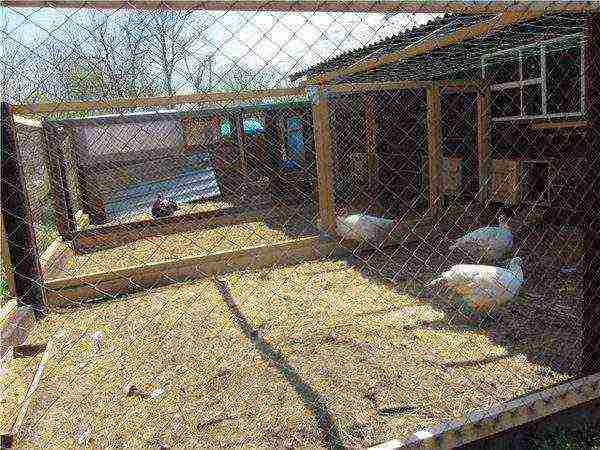
In the winter season, when the air temperature is below 10 degrees, it is also recommended to let turkeys go for walks. To do this, a layer of straw is lined on the territory of the corral so that the birds do not freeze their paws, and feed is scattered throughout the corral.
Walking turkeys is simply necessary, otherwise they will only get fat without gaining muscle mass.
Most turkey breeders keep heterosexual individuals separately.
In this case, only one manufacturer is launched to females. But there are poultry farmers who prefer to keep all birds in one enclosure. In this case, there should be no more than 5 females per male in a turkey flock, otherwise he will not be able to cover all the turkeys.
If the herd of turkeys is large, then it is better to divide it into small groups., each of which will have one manufacturer.
Care and feeding during puberty
Puberty in turkeys occurs at the age of 8-10 months. For the most complete development, turkeys must be fed with a special mixture, which consists of:
- Yeast - 5 grams;
- Carrots and greens 70-80 grams;
- Cottage cheese 20 grams;
- Sprouted corn 100g.
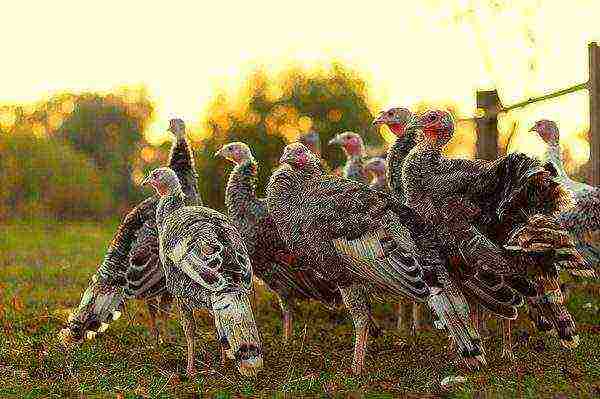
The turkey begins to lay eggs from 10 months. Very often they suffer from the "brooding" syndrome, so in order to collect the eggs they have taken out, they often have to drive them away.
It is very important to monitor the feeding of the roosting individuals. When birds are just starting to lay, they need to be fed up to 5 times a day. In the winter season, you need to give moistened cereals, finely chopped carrots, grass flour. In the summer, cereals with herbs.
After mating, the egg-laying process begins.
How to maintain and grow
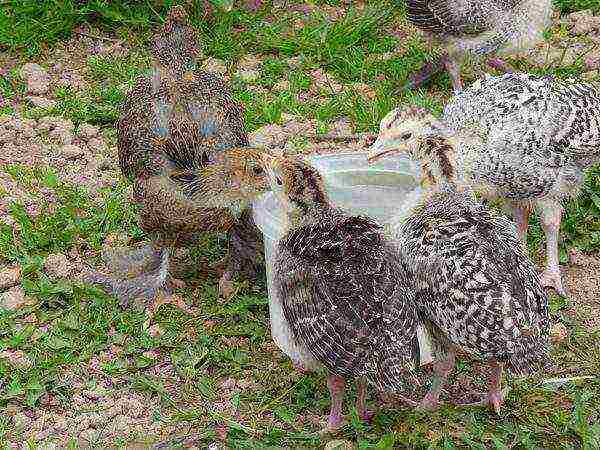
During lay, a young turkey can lay up to 17 eggs that need to be tested for fertility. To do this, the eggs must be lowered in turn into a container of water, if the egg sinks, then we return it to the nest, if it floats up, to the refrigerator.
The hatching process lasts up to 28 days. During this time, make sure that the turkey eats on time. Feeding is done in the morning.It is best to feed the hen with soaked and swollen oats. When the turkey is eating, it is imperative to cover the eggs with a warm cloth for this time to prevent hypothermia.
One turkey is able to hatch and raise not only its offspring, but also someone else's. One bird is capable of raising 75-80 turkeys.
How to keep and how to care for turkeys
The heat factor is the basis for growing turkey poults. Chilled young animals are highly susceptible to various diseases, which can prevent them from gaining the necessary weight, even with a good balanced feed.
Turkey poults should be bred in cardboard boxes with fabric bedding, or dry fine sawdust. For 10 babies, a container with dimensions of one meter by one meter and a wall height of up to 40 cm is suitable.
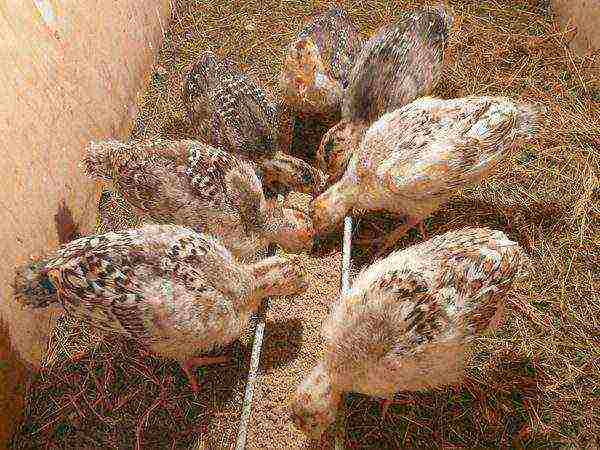
Heating and lighting is carried out by electric lamps, the power of which must be at least 40 watts. Light bulbs are fixed on top of the box, using a table lamp. You can lower the lamp directly into the box, but for this, it is necessary that it be in a special weighted glass shade.
The first two days, turkeys are kept under round-the-clock lighting, gradually reducing the light regime by 30-35 minutes.
From 20 days, the light regime lasts 15 hours. In addition, for the first 10 days of babies' life, it is worth maintaining the temperature to +36 degrees, gradually lowering and bringing it to + 25 degrees. At two months, the temperature should be +20 degrees.
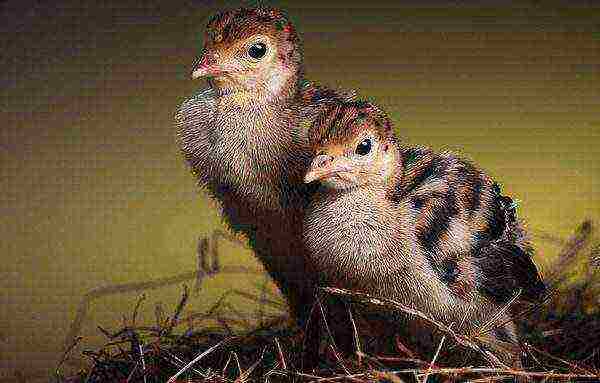
Under such conditions, it is recommended to keep the turkey poults until the end of feeding., that is, up to 7 months.
Turkeys are prone to developing diseases, most of which are fatal.
The main diseases of domestic turkeys and turkeys
- Coccidosis - the development of the simplest microorganisms in the bird's body, leading to the death of the carrier.
- Trichomoniasis incidence occurs in the body of birds when Trichomonas is absorbed when drinking water, or contact with other species of birds that are carriers of the infection.
- Tuberculosis... It develops if the rules for keeping turkeys are not followed. Direct sunlight is the only source of healing for a sick bird.
- Pasteurellosis... Most often occurs in fattened turkey poults, whose age is from 1 to 2 months. The reason is the pecking of manure by turkeys and the harmful substance pasteurella contained in it, which is destroyed from direct sunlight in a day.
- Development parasitic organisms in the digestive tract.
- Aspergillosis - a fungal disease of the pulmonary system of organs, which develops as a result of the presence of straw or other litter on the territory of the aviary, containing fungal microorganisms.
Prevention of young stock during rearing
- On the 1st day, the solution is drunk ascorbic acid with glucose, since the turkey is still weak and unable to assimilate other complex elements;
- From the second to the fifth day is given irex vital (a pinch is diluted per liter of water);
- You can also amino-vital (pinch per liter of water).
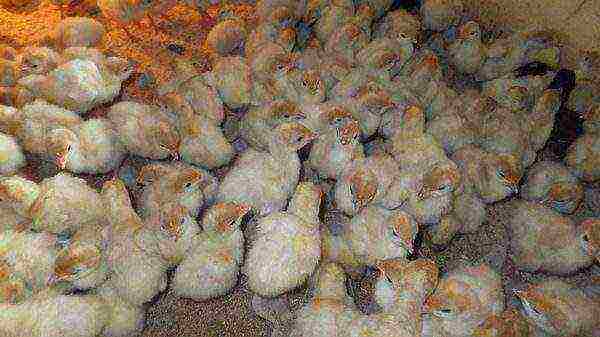
The earlier the poultry begins to feed, the more viable they become. On the first day, it is best to feed a hard-boiled and minced egg.
Then a specialized compound feed is given for young animals up to 40-45 days old, and also include milk mash, return, sour milk and buttermilk in the diet. It is imperative to give the kids finely cut nettle, dandelion, and clover greens. In a month and a half, you can transfer them to an adult diet.
- From 6th to 10th day given to chicks in small quantities furozolidone, which is for the prevention of gastrointestinal diseases;
- From the 15th to the 20th day, turkey poults need to be drunk amproliumwhich goes against coccidia;
- Before releasing turkey poults for walking, you need to give them ASD-2 - faction against fungal and aspergillosis;
- In 40 days it is soldered metronidazole, within 4 days (4 tablets per liter of water). It will protect the young from the development of the simplest microorganisms that are formed when the earthworms chew and can cause the death of the turkey.
What to feed the birds
In preparation for the winter period, it is recommended to harvest linden, birch and poplar brooms for turkeys, which are subsequently hung in the house at a height accessible to turkeys and are a source of additional vitamins.
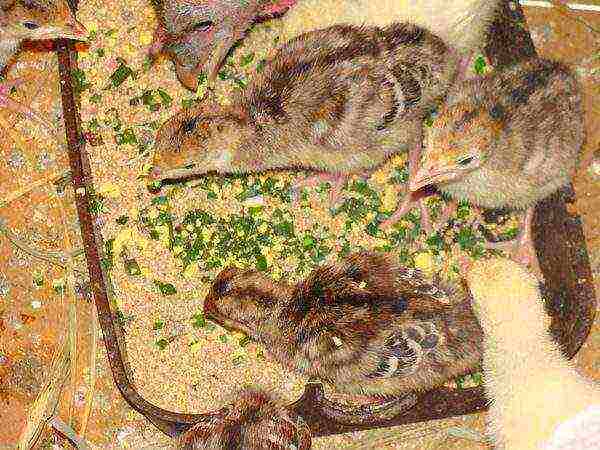
The diet of adults includes:
- Compound feed, which contains proteins, vitamins and proteins. Usually used to feed brood males.
- Oatspreferably sprouted.
- Best fed to turkeys for fattening wheat.
- Tops vegetable crops (in summer).
- Shredded vegetables (potatoes, carrots, turnips).
- Greens (alfalfa, green onions, clover, dandelions).
- Young twigs trees, hay, sauerkraut (in winter).
If you raise a poultry for fattening, then you need to feed it more with wheat and other grains. During morning feeding, it is better to moisten grain crops with water, and give dry food in the evening. In order for the meat to be tender and juicy, you need to feed greens and vegetables as much as possible.
In order for laying turkeys to be carried in a balanced way, their diet should also include:
- 150 grams boiled potatoes per day, despite the fact that the laying hen produces up to 9 eggs per month, if from 15 to 18 eggs per month, then potatoes, respectively, from 110 to 130 grams.
- Bone flour and table salt should be up to 2 grams daily, regardless of how many eggs the bird gives out.
- Fish waste should be 30 grams for 9 eggs per month, 40 grams for 15 eggs per month, 50 grams if the turkey produces 18 eggs.
- Cottage cheese, if laying hens is 3 eggs per month, then 3 grams per day, 9 eggs, then 5 grams, 15-20 eggs, then 10 grams.
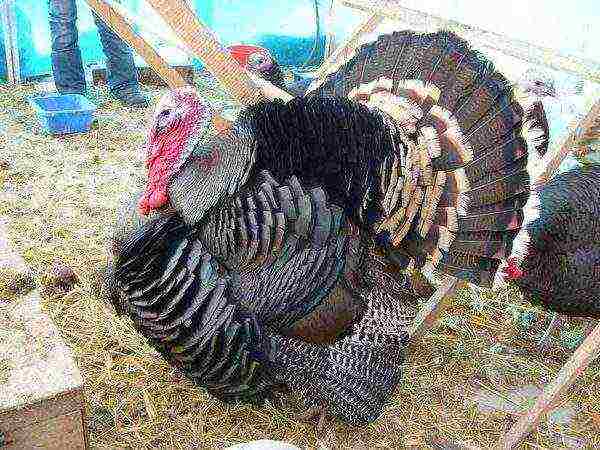
Breeding turkeys on a personal backyard, subject to all the necessary measures for the care and rearing of young animals, will become a very interesting and profitable activity even for a novice farmer.
Maintain and raise a free-range turkey herd in summer and cellular content in winter will give a large number of large eggs and dietary meat, enriched with vitamins and various microelements. Recently, broiler turkey breeds, which are kept for fattening, are gaining popularity. They are not picky about food and are easy to maintain.
